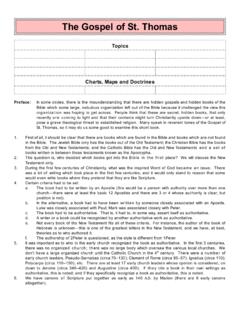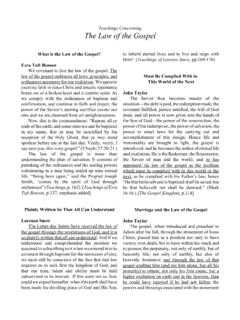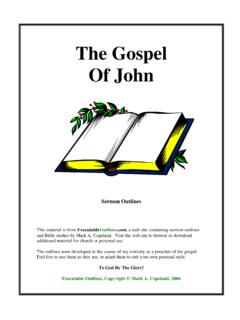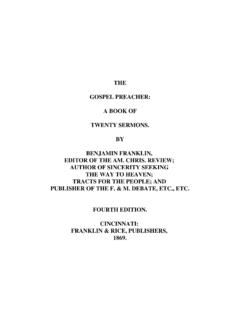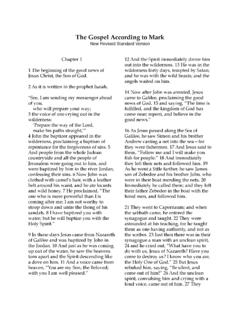Transcription of Preaching From the Gospel of John - A seminary …
1 1 Bruce McLarty Preaching from the Gospel of John 2013 Sermon Seminar Austin Graduate School of Theology Preaching From the Gospel of John Session 1 The Unique Contribution of the Fourth Gospel Richard A Burridge (Four Gospels, One Jesus?) examines an early understanding by Irenaeus (d. 202) of Ezekiel 1:10 and Revelation 4:7 in which Irenaeus argues that these prophecies required that there be four no more and no less gospels. By the time of Jerome (347-420), the identification had come to be Matthew = Human face, Mark = Lion, Luke = Ox, and John = Eagle. While this interpretation is not convincing, the symbolism can be useful in helping Christians appreciate the special contributions made by each of the four gospels. Matthew The Gospel with a Human Face 1. 42% unique material 2.
2 5 great sermons, each ending with and it happened when Jesus had completed these (7:28; 11:1; 13:53; 19:1; 26:1) 3. Jesus is viewed primarily as Messiah. 4. A very Jewish Gospel 5. Sometimes an almost anti-Jewish Gospel Mark The Bounding Lion 1. 7% unique material 90% is repeated in Matthew 2. Fast paced Key word is immediately (42 times)..Mark s vividness and pace; no one knows where the lion comes from, or where he is going as he leaps on. (Burridge, Four Gospels, One Jesus?, 37) 3. Dark, suffering, fearful tone 4. Drama in recognition of who Jesus is 5. Emphasis on miracles 2 Bruce McLarty Preaching from the Gospel of John 2013 Sermon Seminar Austin Graduate School of Theology Luke The Plodding Ox 1. 58% unique material 2. Slow, steady, lumbering Gospel Jesus relentlessly heading to Jerusalem 3.
3 Emphasizes the Holy Spirit, women, and the disadvantaged 4. A very orderly account (1:3) of the events of Jesus life 5. A special focus on parables John The Soaring Eagle 1. 92% unique material 2. Most theological or spiritual Gospel the view from 10,000 feet high 3. Simple, repetitive vocabulary 4. Key purpose belief (20:30-31) 5. No parables or casting out of demons Do you have a picture of Jesus? 3 Bruce McLarty Preaching from the Gospel of John 2013 Sermon Seminar Austin Graduate School of Theology 4 Bruce McLarty Preaching from the Gospel of John 2013 Sermon Seminar Austin Graduate School of Theology Introduction to the Fourth Gospel 1. Irenaeus (c. 130-200): John, the disciple of the Lord, who leaned on his breast, also published the Gospel while living at Ephesus in Asia (Haer.)
4 ; quoted in Eusebius Hist. Eccl. ) 2. Clement of Alexandria (c. 155-220) made the famous assertion that after Matthew, Mark, and Luke had been written, John, perceiving that the bodily facts had been made plain in the Gospels, being urged by his friends, and inspired by the Spirit, composed a spiritual Gospel (Eusebius Hist. Eccl. ). 3. Origen (c. 185-254) regarded the Gospels as the firstfruits of all Scripture and the Gospel of John as the firstfruits of the Gospels. 4. John Calvin (1509-1564) .. observes that the Synoptic Gospels allow us to see the body of Jesus, whereas John reveals the soul of Jesus. (Carl R. Holladay, A Critical Introduction to the New Testament, 192) 5. R. Alan Culpepper observes in the introduction of his commentary on John in the Interpreting Biblical Texts series, John is arguably the most influential book of the New Testament (page 13).
5 6. What John does not have: In John we do not find parables, demon exorcisms; healing of lepers; tax collectors; Sadducees; table fellowship with sinners; infancy narratives; the temptation of Jesus; the Transfiguration; the material in Matthew s Sermon on the Mount; or the institution of the Lord Supper (M. M. Thompson, Gospel of John in Dictionary of Jesus and the Gospels, 374). 7. What John does have: Jesus baptismal ministry at the Jordan; the encounters with Nicodemus and the Samaritan woman; the I am sayings, coupled with long discourses, most of the material in chapters 7-11, and 14-17; the footwashing; and Jesus conversation with Pilate. Of the Johannine miracles only the feeding of the five thousand is found in the other Gospels (M. M. Thompson, Gospel of John in Dictionary of Jesus and the Gospels, 374).
6 8. Time: The story line in the Synoptic Gospels could be compressed into a single year. John specifically mentions three different Passovers, giving us the perspective of a three-year public ministry. 9. Place: The Synoptics describe a single trip to Jerusalem. John describes a ministry that oscillates between Galilee and Judea. 5 Bruce McLarty Preaching from the Gospel of John 2013 Sermon Seminar Austin Graduate School of Theology 10. Preaching From the Gospel of John Session 2 The Big Picture and a Number of Smaller Ones The Big Picture: 1. Purpose Statement: Jesus did many other miraculous signs in the presence of his disciples, which are not recorded in this book. But these are written that you may believe that Jesus is the Christ, the Son of God, and that by believing you may have life in his name (John 20:30-31).
7 A. Evangelism? ( begin to believe pisteus te) b. Exhortation? ( go on believing pistu te) c. Probably both! 2. Outline: C. H. Dodd, in The Interpretation of the Fourth Gospel , saw the following outline: i. The Proem (chapter 1) ii. The Book of Signs (chapters 2-12) iii. The Book of the Passion (chapters 13-22) Brown calls it Book of Glory iv. Some consider chapter 22 as an epilogue 3. Building Faith: A Sacred Mystery: I have my Acts students write a reflection on the role that God, speakers, and their own will have played in their faith development (Acts 13:48; 14:1; 14:2). 4. We should stop explaining and start proclaiming. (Richard B. Hays, The Materiality of John s Symbolic World in Preaching John s Gospel : The World it Imagines, 8). The endless quest for the key to understanding the Gospel of John can keep us from proclaiming the Gospel as we should.
8 A Number of Smaller Pictures: (Some regard one of these themes as the key to understanding all of the Gospel of John. Perhaps they are better viewed as different windows that let light into the chapel of John s Gospel .) 1. Above and below: This cosmological dualism is regarded by Holladay as the essence of John s theological vision (Holladay, 206). It is clearly seen in 3:31-36. 6 Bruce McLarty Preaching from the Gospel of John 2013 Sermon Seminar Austin Graduate School of Theology 2. Yes-or-no world: John doesn t contain shades of gray. You are either in or out, either for or against, either standing in the light or hiding in the darkness (John 9). 3. Incarnation: Culpepper (71) quotes Bultmann as saying, The theme of the whole Gospel of John is the statement: The word became flesh.
9 4. Boldly confessing your faith: The word aposunag gos appears 3 times in John: 9:22; 12:42; 16:2. The man born blind and Nicodemus are two excellent examples of the challenge to boldly confess one s faith. (Emphasis in David Rensberger, Joannine Faith and Liberating Community) 5. Signs and faith: There are seven signs in the Gospel of John: i. Turning water into wine (2:1-12) ii. Healing the official s son (4:46-54) iii. Healing the lame man on the Sabbath (5:1-18) iv. Feeding the 5,000 (6:1-15) v. Walking on the water (6:16-21) vi. Healing the man born blind (Chapter 9) vii. Raising Lazarus (11:1-44) 6. Signs and words: Tom H. Olbricht has an excellent chapter on The Word as Sign in Preaching John s Gospel , edited by David Fleer and Dave Bland. He states, Both the words and works of Jesus are signs (84).
10 Nathaniel is a good example of this (1:48-49). Mark Frost has a powerful story along this line in Preaching John s Gospel regarding Mrs. Butler, Hayes Avenue Church of Christ, Detroit, Michigan (104). 7. Glory: Glorify appears 23 times in John, and glory appears 18 times. Leon Morris, in the New International Commentary on the Gospel of John, writes that John may have found it difficult to find a place for the Transfiguration (which concentrates the manifestation of Jesus glory into one magnificent story) in the face of the fact that one of his major themes is that Jesus glory was manifested continually in the path of lowly service, and that it was preeminently shown on the cross (18). 8. Invitation to join the journey of faith: Like a figure in the bottom corner of a Norman Rockwell painting, Nicodemus (3:1ff; 7:50ff; 19:39ff) and the Samaritans (4:39-42) invite us into the story of the Gospel of John and point the way forward.


